Near the end of 1972, Intel introduced their first 8-bit microprocessor, the 8008. Decades later, this processor still influences computing; you probably use an x86 processor that is a descendent of the 8008. One unusual feature of the 8008 processor is its use of a "bootstrap load" or "bootstrap capacitor", a special capacitor circuit to improve performance.1 Federico Faggin, who led the development of the 8008, is the main character in this story; he invented a new way to fabricate bootstrap capacitors for the Intel 4004 and 8008 processors and says it "proved essential to the microprocessor realization" and "without [the bootstrap load], there was no microprocessor."
My photo above shows the tiny silicon die inside the 8008 package. You can barely see the wires and transistors that make up the chip. There are 90 bootstrap capacitors, visible as small yellow rectangles, especially in the upper center. The squares around the outside are the 18 pads that are connected to the external pins by tiny bond wires. 18 pins is a very small number for a microprocessor, but Intel was bizarrely committed to small packages at the time.2 This required inconvenient tradeoffs; the lack of multiple power pins was one factor forcing the use of bootstrap loads.
The 8008 processor's history is more complex than you might expect. Its roots are the Datapoint 2200, a popular computer introduced in 1970 as a programmable terminal. Created before the microprocessor, the Datapoint 2200 contained a board-sized CPU build from individual TTL chips. Datapoint talked with both Intel and Texas Instruments about replacing the processor board with a single MOS chip. Texas Instruments created the TMX 1795 processor in March 1971, while Intel created the 8008 around the end of 1971 but Datapoint rejected both chips for a variety of reasons. Texas Instruments abandoned the TMX 1795 after their attempts to market it failed. Intel, on the other hand, marketed the 8008 as a general-purpose microprocessor, creating the microprocessor industry.
(You might wonder how the Intel 4004 fits into this story. The Intel 4004 is architecturally unrelated to the 8008 in almost every way; despite the similar names, the 8008 is not an 8-bit version of the 4-bit 4004. After the Intel 4004 was launched in 1971, much of the 4004 team (including Faggin, Hoff, Mazor, and Feeney) moved over to the 8008 project. Because the 4004 and 8008 processors were built by the same team with the same PMOS3 process, they have some layout and circuit-level similarities, in particular the bootstrap load circuit.)
Why the bootstrap load?
The purpose of the bootstrap load is to get extra voltage out of a transistor when necessary. To explain this, I'll start by showing how an inverter works when implemented in a processor. The diagram below shows an inverter, built from a PMOS3 transistor and a load resistor (which is actually a transistor). If the input to the inverter is 0 (low), the lower transistor turns on, pulling the output high (1). But if the input is 1 (high), the output transistor turns off. In that case, the load resistor pulls the output low (0). Thus, the input signal is inverted.
The diagram below shows the physical implementation of an inverter in the 8008 processor. The first die photo shows the inverter as it appears in the chip. The horizontal metal wiring on top provides VDD and the input to the circuit. For the second photo, I dissolved the metal layer to reveal the two transistors that form the circuit. The schematic on the right matches the physical layout of the transistors on the die but otherwise corresponds to the schematic above. Because creating resistors in an integrated circuit is inconvenient, the load resistor is implemented by a transistor.
There's a complication from using a transistor as a load resistor: these MOS transistors have a property called the threshold voltage VT. The problem is that when you try to pull a signal low, the transistor can't pull it all the way low. Although you'd like the signal to get pulled down to VDD (-9 volts), the threshold voltage (say -5 volts)9 means that you can only get the signal down to -4 volts. (This is one of the reasons why the 8008 requires a much larger voltage (15 volts overall) than modern integrated circuits; if you tried to run it at 5 volts, the threshold voltage would consume the entire signal.)
The diagram below explains the threshold voltage in more detail. VD, VG, and VS are the voltages on the drain, gate, and source respectively. VGS is the voltage between the gate and the source. The transistor will turn on if VGS < VT, the threshold voltage. (Inconveniently, most of these voltages are negative in a PMOS transistor, which makes things confusing.) The problem is that with a gate voltage of -9 volts and a threshold voltage of -5 volts, the transistor will only be on if VS is higher than -4 volts. Thus, the transistor can't pull VS lower than -4 volts. The only way to get VS lower is if you had a more-negative gate voltage, at least -14 volts in this case. Some chips solve this by using an additional voltage supply to provide more voltage to the gate, such as the Intel 8080 or the HP Nanoprocessor.
The threshold voltage isn't much of a problem when you're dealing with inverters and other gates, because the voltage levels are restored by each gate. However, there are two places where the threshold voltage is a problem: superbuffers and pass transistor logic. In these circuits (described in the footnote4), the threshold voltage drop happens twice, yielding an output that is too weak. Since these circuits are common in processors, a solution was needed: the bootstrap load. It is a way of generating more voltage for the gate to overcome the threshold voltage so the transistor to pull its output all the way to VD.
How the bootstrap load works
The bootstrap load is essentially a charge pump circuit that uses a bootstrap capacitor to boost the gate voltage. The diagram below shows the basic idea of a charge pump. On the left, a capacitor is charged to -9 volts from a voltage source. If you disconnect the voltage source and then re-connect the negative side to the capacitor as shown on the right, the capacitor retains its charge of -9 volts. However, since the lower side of the capacitor is now at -9 volts, the upper side of the capacitor is now at -18 volts. The bootstrap load uses this -18 volts as the gate voltage, sufficient to overcome the threshold voltage.
The diagram below shows the bootstrap load circuit. The circuit is similar to the inverter described earlier, but with the addition of a capacitor and a transistor. In the first diagram, a 0 input turns on the lower transistor (Q1), yielding a 1 output (+5 volts). Meanwhile, Q3 acts as a load resistor, pulling the top of the capacitor to -4 volts (not -9 volts due to the threshold voltage.) This results in -9 volts stored across the capacitor.
The second and third diagrams show what happens with a 1 input. The lower transistor Q1 turns off, allowing Q2 to pull the output low. With a regular inverter, -4 volts is as low as the output can go (second diagram). However, as explained earlier, the capacitor still holds -9 volts, so the top of the capacitor must be -13 volts. With -13 volts on the gate of Q2, Q2 will continue to pull the output lower, until the circuit ends up as shown on the right, with the output pulled all the way down to -9 volts. Note that the source can't get pulled down any lower than the drain, regardless of the gate voltage. (In comparison, the simple inverter described earlier could only pull the output down to -5 volts.)5
The image below shows part of Intel's schematic for the 4004 processor, showing the circuit for a standard load and the circuit for the bootstrap load, indicated by a "B" next to the resistor.
The silicon-gate bootstrap load
So far, I've discussed the bootstrap load, which was extensively used with MOS circuitry, and was patented by North American Rockwell in 1966. The invention necessary for the 4004 and 8008 processors was the extension of the bootstrap load to silicon-gate integrated circuits.
One of the key inventions that made the 8008 practical was the self-aligning silicon gate transistor.6 The diagram below shows the structure of an MOS transistor. Early MOS integrated circuits used metal-gate 7 transistors, which used metal, typically aluminum, instead of polysilicon for the gate. But at Fairchild in 1968, Faggin and Klein invented a practical way to make transistors with silicon gates. This may seem like a trivial difference, but silicon-gate transistors were better than metal-gate transistors in three important ways. First, the electrical properties of silicon-gate transistors are much better than metal-gate transistors, running faster and at lower power. Second, polysilicon provided a second layer for routing signals, making integrated circuit layouts much more compact.
Finally, polysilicon permitted construction of self-aligned transistors, which play an important part in the bypass capacitor story. Integrated circuits are constructed through a sequence of processing steps, using optical masks and photo-sensitive resist to create patterns on the surface. An integrated circuit with metal-gate transistors is constructed from the bottom up. First, the source and drain regions are doped with impurities to form P-type silicon, as shown below. In a later step, the metal gate is created between the source and the drain, using a different mask. The tricky part is making sure the gate is lined up with the source and the drain; if there's a gap, the transistor won't work. Thus, a metal gate is made larger than necessary so it will still cover the gate channel, even if the alignment of the layers is slightly off. Unfortunately, this overlap creates capacitance and harms performance.
On the other hand, the self-aligned gate is created in the opposite order. The polysilicon gate is created first. In a later step, the source and drain regions are doped. However, a mask isn't used to separate the source and drain from the gate. Instead, the gate itself blocks doping of the region in between the source and drain. Thus, the source and drain are automatically "self-aligned" with the gate, eliminating the excess capacitance from a too-large gate. (Why couldn't metal gates be self-aligned? Because doping the silicon requires high temperatures that would melt the metal, but polysilicon can handle the heat.)
Although self-aligned silicon gates are a major improvement over metal gates, there was one drawback: capacitors. With metal-gate transistors, a capacitor could be easily constructed by using metal and doped silicon as the plates: a large metal layer on top, doped silicon underneath, and a thin insulating oxide layer in between. (In other words, a transistor with a large gate is used as a capacitor.) With self-aligned gates, the polysilicon gate could be used as a capacitor plate in place of the metal layer. However, in the self-aligned process, the polysilicon gate blocks doping of the silicon underneath, which is good for a transistor but bad for a capacitor, since you can't dope the silicon under the polysilicon plate. (You could use an extra manufacturing step to dope the capacitor plates before creating the polysilicon gate, but this extra step would increase the cost.)
Faggin invented a solution that made capacitors practical with self-aligned gates.8 He realized that if you bias the capacitor correctly, the charge on the upper plate will create a conductive region in the silicon underneath it, even without any doping. He tried this at Fairchild and discovered that it worked. This solved the problem of how to use a bootstrap load with self-aligned silicon-gate transistors.
The photo above zooms in on one of the boostrap load circuits in the 8008, used in an inverter. The diagram below shows the underlying silicon after removing the metal layer. The bootstrap capacitor is constructed by a layer of polysilicon (pinkish) over the underlying silicon, forming the capacitor plates. The transistor on the right inverts the input. The capacitor is charged by the transistor in the lower left. The load transistor is in the middle; the capacitor provides the boosted voltage to its gate. The transistors have varying sizes depending on their roles. The inverting transistor is the largest since it provides the most current. The transistor that charges the capacitor is very small in comparison because a small current can keep the capacitor charged.
This bootstrap load technique was extensively used in the 4004 and 8008 processors. The diagram below shows the bootstrap loads in the 8008 processor, indicated with a red box. The 8008 has 90 bootstrap loads, so it is a significant circuit. Many bootstrap loads are around the periphery of the chip to help drive the output pins. The instruction register (upper center) uses bootstrap loads to drive the relatively large instruction decoder (center). At the right, bootstrap loads drive the register storage (upper right) and stack storage (lower right). Other miscellaneous circuits throughout the processor also use bootstrap loads.
Conclusion
A final question is if the bootstrap load was a key invention that made the microprocessor possible (as embodied in the 4004 and 8008) or if the microprocessor was inevitable regardless of features such as the bootstrap load. One view is that "the buried contact and particularly the bootstrap load, were indispensable to obtain the required speed within the available power budget." Feeney said in an 8008 oral history "that being limited on pins, limited on power supplies, whatever, that the bootstrap load became very, very critical." On the other hand, the development of the microprocessor seemed an inevitable, incremental process to many. Fairchild engineer Lee Boysel said in 1970,10 "The computer-on-a-chip is no big deal. It's almost here now... I've no doubt the whole computer will be on one chip within five years." Hal Feeney of Intel said, "a the time in the early 1970s, late 1960s, the industry was ripe for the invention of the microprocessor."
In the narrow sense, the bootstrap load made the 4004 and 8008 possible with their given size, performance, and power consumption. The bootstrap load also illustrates how the microprocessor is not a single invention, but the aggregation of many smaller inventions that made it possible. However, looking at the broader picture, microprocessors would have been only slightly hampered if the bootstrap capacitor didn't exist. There were many alternatives such as four-phase logic, static logic, higher gate voltages, an additional power supply, or using an extra mask for the capacitors. The Texas Instruments TMX 1795 provides a direct comparison, since it was built at the same time as the 8008 with the same architecture, but using metal-gate transistors instead of silicon-gate. The diagram below shows that the TMX 1795 was considerably larger than the 8008, and it had somewhat worse performance, but the point is that microprocessors would have proceeded essentially the same without the bootstrap load. In any case, by 1974, the switch to NMOS transistors and improvements in threshold voltages made bootstrap loads unnecessary. My conclusion is that the bootstrap load was a helpful innovation, but microprocessors would have proceeded along a similar path even without this invention. Once technology permitted a few thousand transistors to be constructed on an integrated circuit, the single-chip CPU was inevitable.
If you're interested in the 8008, my previous article has a detailed discussion of the 8008's architecture and more die photos; I also explain the 8008's ALU. I announce my latest blog posts on Twitter, so follow me at kenshirriff. I also have an RSS feed.
Notes and references
-
Bootstrap loads in the Intel 4004 are discussed by Insanity 4004 here and here. ↩
-
In his oral history, Faggin describes Intel's fixation on 16-pin packages. When a memory chip required 18 pins instead of 16, it was "like the sky had dropped from heaven. I never seen so [many] long faces at Intel, over this issue, because it was a religion in Intel; everything had to be 16 pins, in those days. Everything had to be 16 pins... It was a completely silly requirements to have 16 pins." At the time, other manufacturers were using 40- and 48-pin packages, so there was no technical limitation, just a minor cost saving from the smaller package. ↩
-
The classic microprocessors such as the 8080, 6502, and Z-80 were built with NMOS transistors. The earlier 4004 and 8008 used PMOS transistors, which were easier to manufacture but had poorer performance. If you're familiar with NMOS logic, PMOS logic is a mirror world, where everything is backward. PMOS used negative voltages, which were also significantly higher than the 5 volts used by standard TTL. For compatibility with TTL levels, the 8008 ran with Vcc at +5V and Vdd at -9V, so it could produce TTL-compatible outputs of roughly 0 volts and 5 volts. (See the datasheet for more details.) The 4004 required -15 volts, typically Vdd = -10V and Vss = +5V. Confusingly, the 4004 defined logic "0" as the more positive voltage and logic "1" as the more negative voltage (datasheet). ↩↩
-
The "superbuffer" replaces the load resistor with an active transistor and is used when more current is required, for instance to drive an internal bus or an output pin. The upper transistor is driven by an inverter, so it is on when the lower transistor is off. Instead of the weak current from the load resistor/transistor, this transistor provides a high current. The problem is that the threshold voltage limits the voltage from the upper transistor. With a regular inverter, the inverter output loses VT, so it will provide -4 volts to the upper transistor's gate. Losing another VT there yields an insufficient output voltage of +1 volt instead of the desired -9 volts.
A superbuffer provides a fast, high-current output in both directions.The second case where the threshold voltage drop is a problem is with a pass transistor, used for dynamic logic. The diagram below illustrates a simple pass transistor circuit. When the control signal is low, the transistor is active, passing the input signal through to the output. But when the control signal is high, the transistor stops passing the input. Instead, the previous value is held by the circuit's capacitance (shown in gray) so the output holds its previous value. Thus, pass transistors provide an efficient way of implementing temporary storage. The problem with pass transistors is the threshold voltage. If the control signal on the gate comes from a regular gate, the "on" voltage will be -4 volts due to the threshold voltage loss. The pass transistor causes a second threshold voltage loss, so the lowest it can pull its output is +1 volt, not enough for reliable operation.
A simple pass-transistor circuit.The bootstrap load fixes these problems. By putting a bootstrap load on the inverter in the superbuffer or on the circuit controlling the pass transistor, the drive voltage will be close to -9 volts. Now there is only a single threshold voltage drop, leaving the output at -5 volts, sufficiently negative for reliable operation. ↩
-
This discussion of the bootstrap load is a simplified explanation. The real circuit is affected by stray capacitance, transistor leakage, and other factors, so the output wouldn't be all the way to VDD. One thing I'd like to point out, though, is that you might expect the capacitor's charge to leak out through Q3 as fast as it charged. Although Q3 is treated as a resistor, it also acts as a diode, blocking the capacitor from discharging. (With the capacitor more negative, the roles of Q3's source and drain are reversed and it no longer conducts.) ↩
-
The silicon-gate bootstrap capacitor exemplifies the paths of information between companies at the dawn of the microprocessor era. Practical silicon gate technology was created at Fairchild (with some earlier roots). When employees (including Faggin) left Fairchild for Intel, they took this knowledge with them. (And in some cases took "lots and lots of Fairchild internal confidential documents", see Shima oral history). From Intel, ideas spread to other companies, such as when Faggin leaving Intel to found Zilog, basing the Zilog Z80 on the Intel 8080. ↩
-
Interestingly, in 2007 Intel started using metal gates again in order to scale transistors further (details). In a way, semiconductor technology has gone full circle, back to metal gates, although now unusual metals such as hafnium are used. ↩
-
In the making of the first microprocessor, Federico Faggin says, "bootstrap load was a very popular circuit design trick used in just about all MOS dynamic circuits of that time. It made possible an output signal swing that was not only equal to the power supply voltage, but was also faster than possible with normal MOS loads for the same power dissipation." Faggin describes how he invented the bootstrap load in the 4004 oral history (p11) and the 8008 oral history (p8). Also see Faggin's The MOS silicon gate technology and the first microprocessors. He describes how the bootstrap load is needed for a two-phase design, and how silicon gate technology didn't support capacitors. Faggin's site describes the bootstrap load. Bootstrap load is also described at mosgate. ↩
-
The threshold voltage depends on various properties of the integrated circuit including the gate material and the oxide thickness. I couldn't find a specific value for the threshold voltage in the 8008 processor, but -5 volts seems like the right ballpark (and is a conveniently round number). The book MOSFET in Circuit Design discusses threshold voltages for P-channel devices. ↩
-
The bootstrap load illustrates the social process through which people are assigned credit for inventions and the construction of reputation. Although Faggin had a key role in the 4004 and 8008 processors, "when he left to found Zilog he got temporarily written outside of the Intel history." (See Intel disowns Faggin and Interview with San Mazor.) Faggin states, "They tried to erase my name from all of my contributions, including the silicon gate technology and the first microprocessor, and attribute them to others." After lobbying efforts by Faggin's wife and the pro-Faggin website intel4004.com, Intel reluctantly gave Faggin more credit. Faggin eventually received various awards including the National Medal of Technology and Innovation in 2010, so in the end he received his (deserved) recognition.
The point is that credit is not assigned objectively, but is a dynamic force depending on various corporate and personal forces and who tells the story. (Wikipedia is one modern arena for these conflicts.) One corrective is the book History of semiconductor engineering, which covers many of the key people in the history of integrated circuits, with little regard for the "generally accepted" history. I should make it clear that I am drawing most heavily on Faggin's writings for background on the bootstrap load, so this blog post should not be viewed as an "objective" view of who should get credit for it. It looks like the silicon-gate bootstrap load was invented simultaneously at National Semiconductor; patent 3912948 filed in 1971 by Dilip Bapat describes an identical silicon-gate bootstrap load circuit. ↩
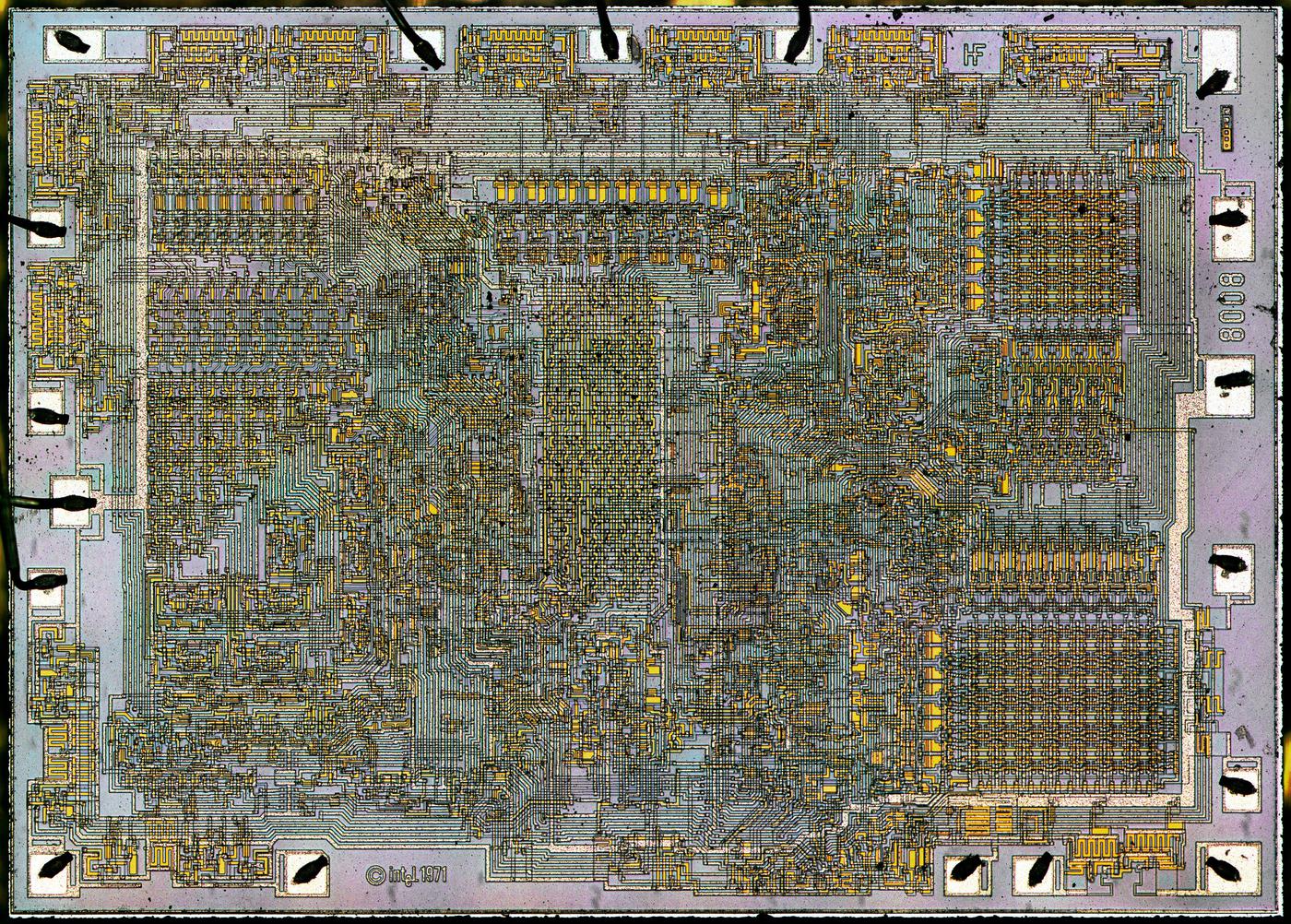
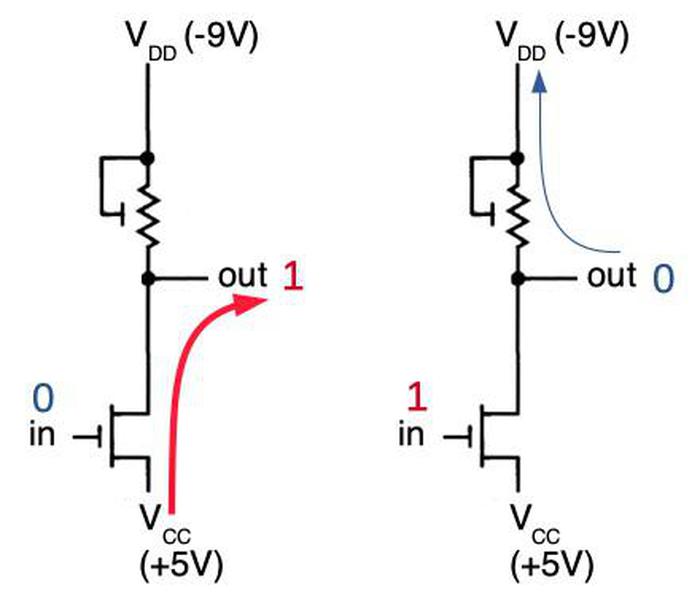
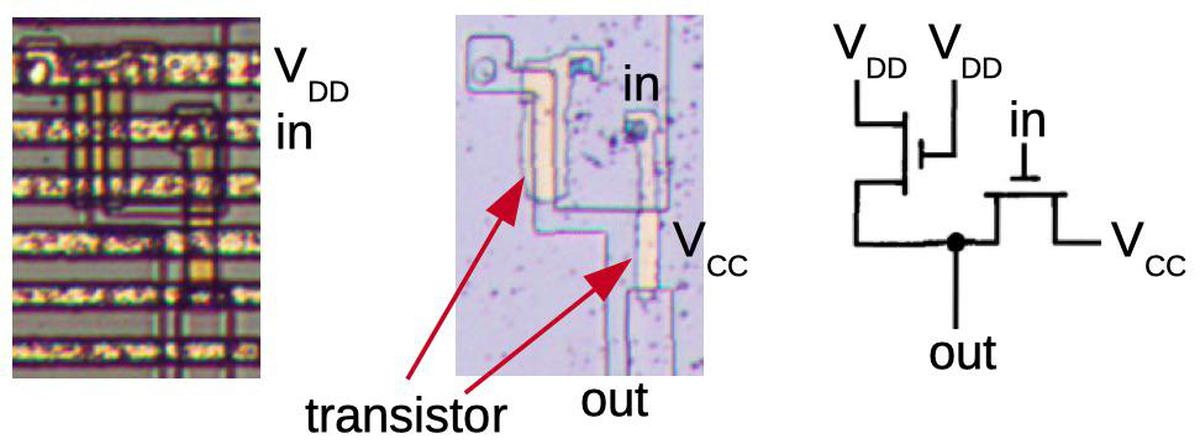
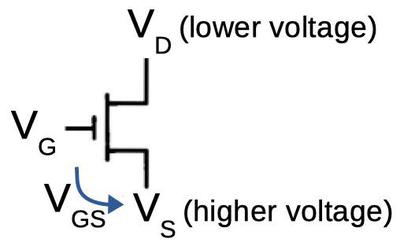

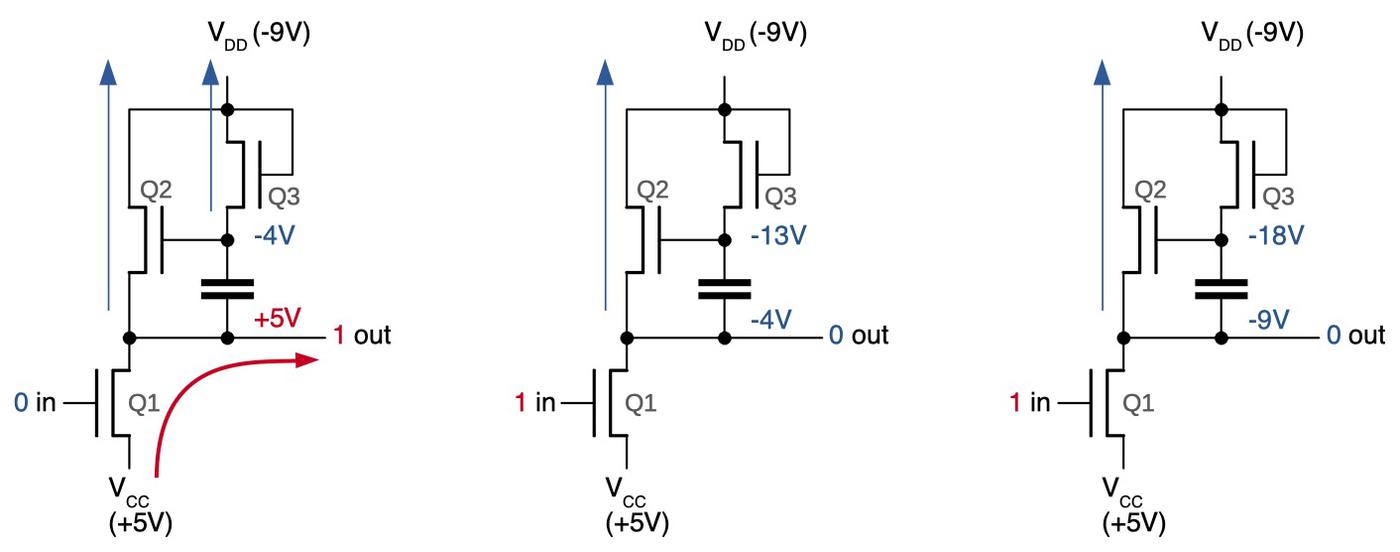
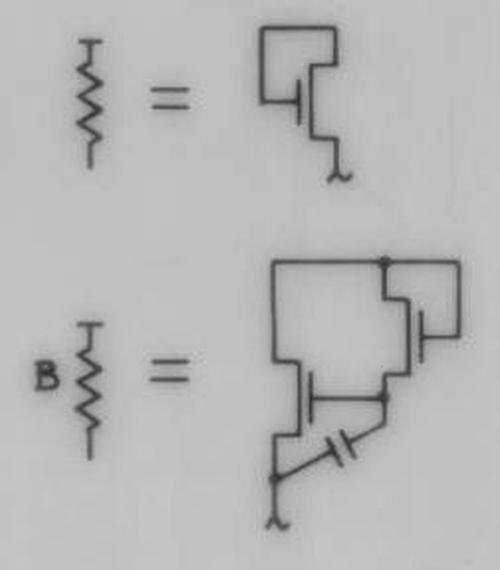
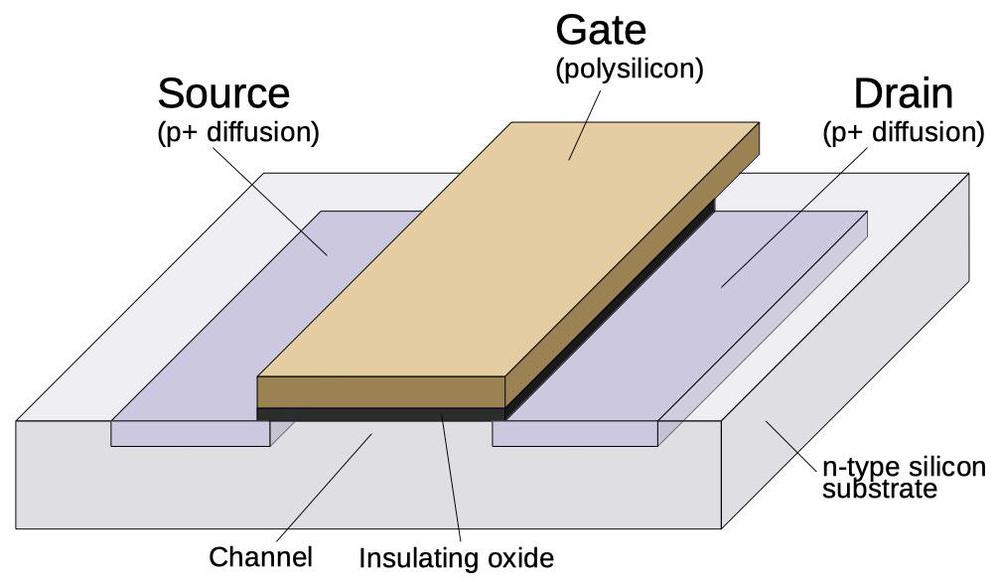
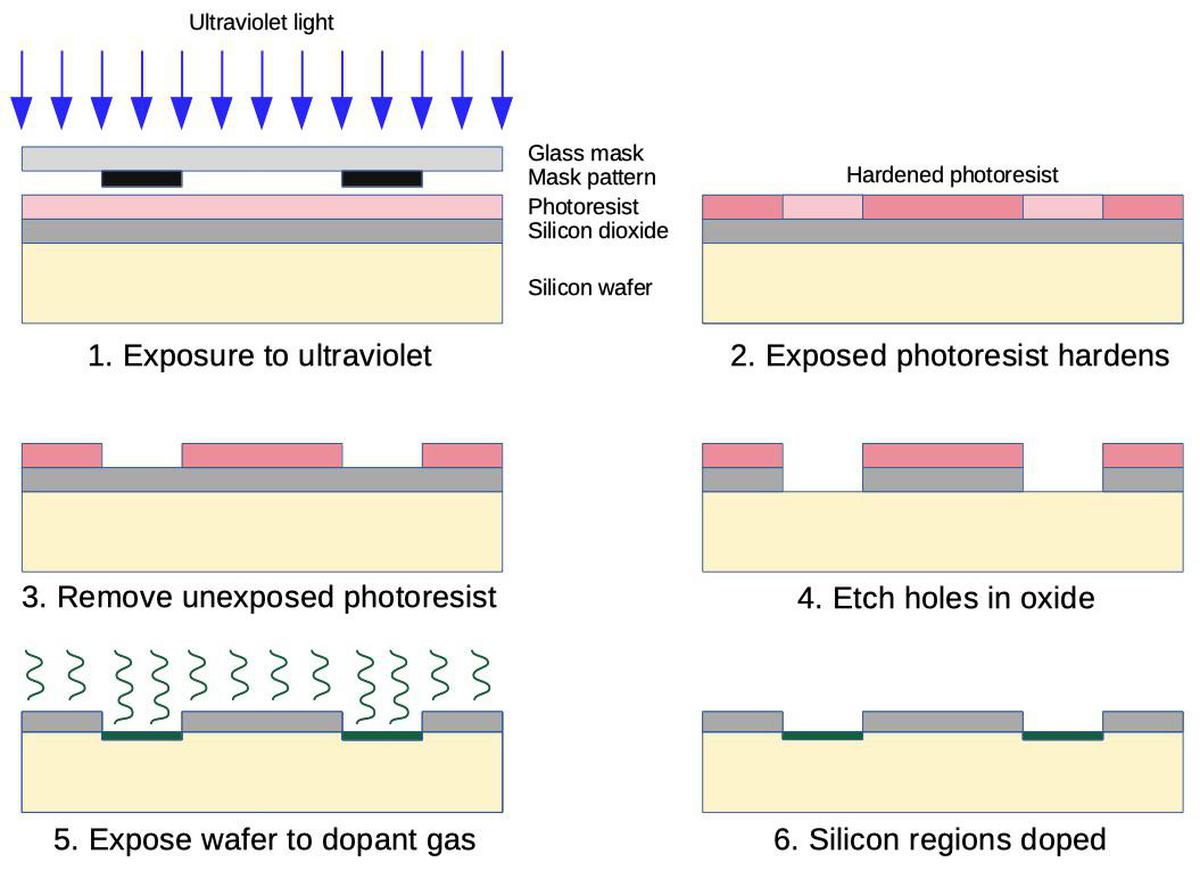
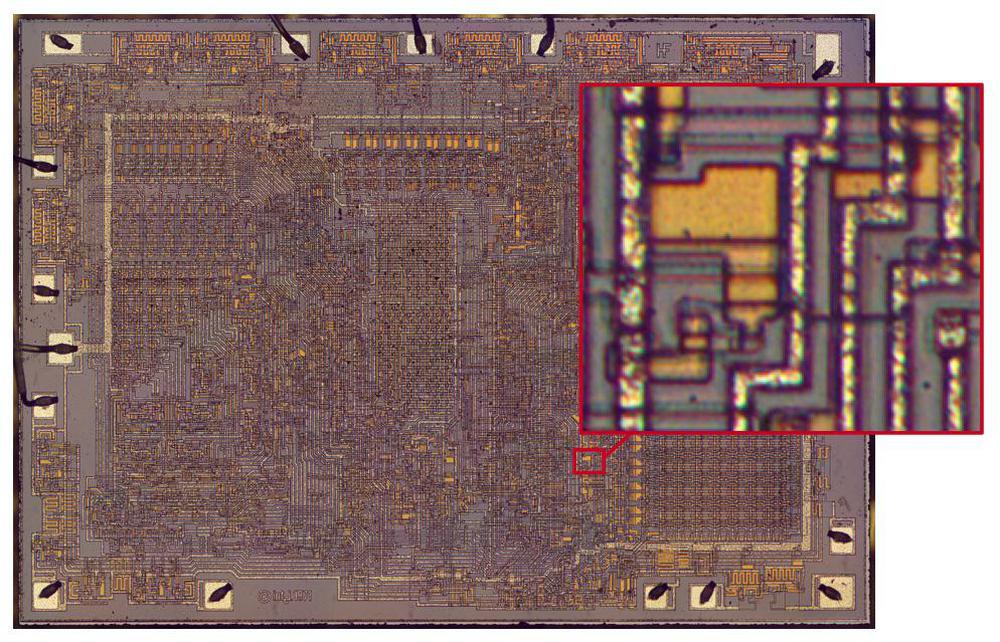
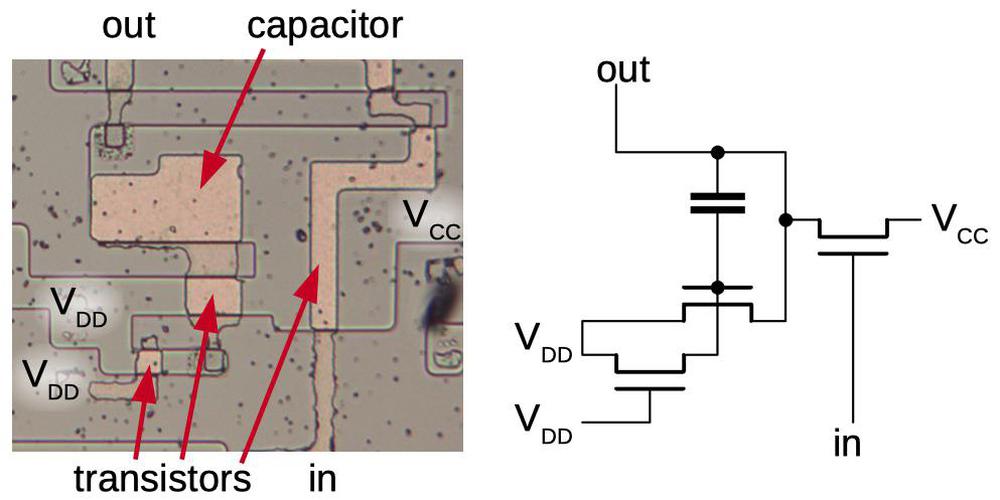
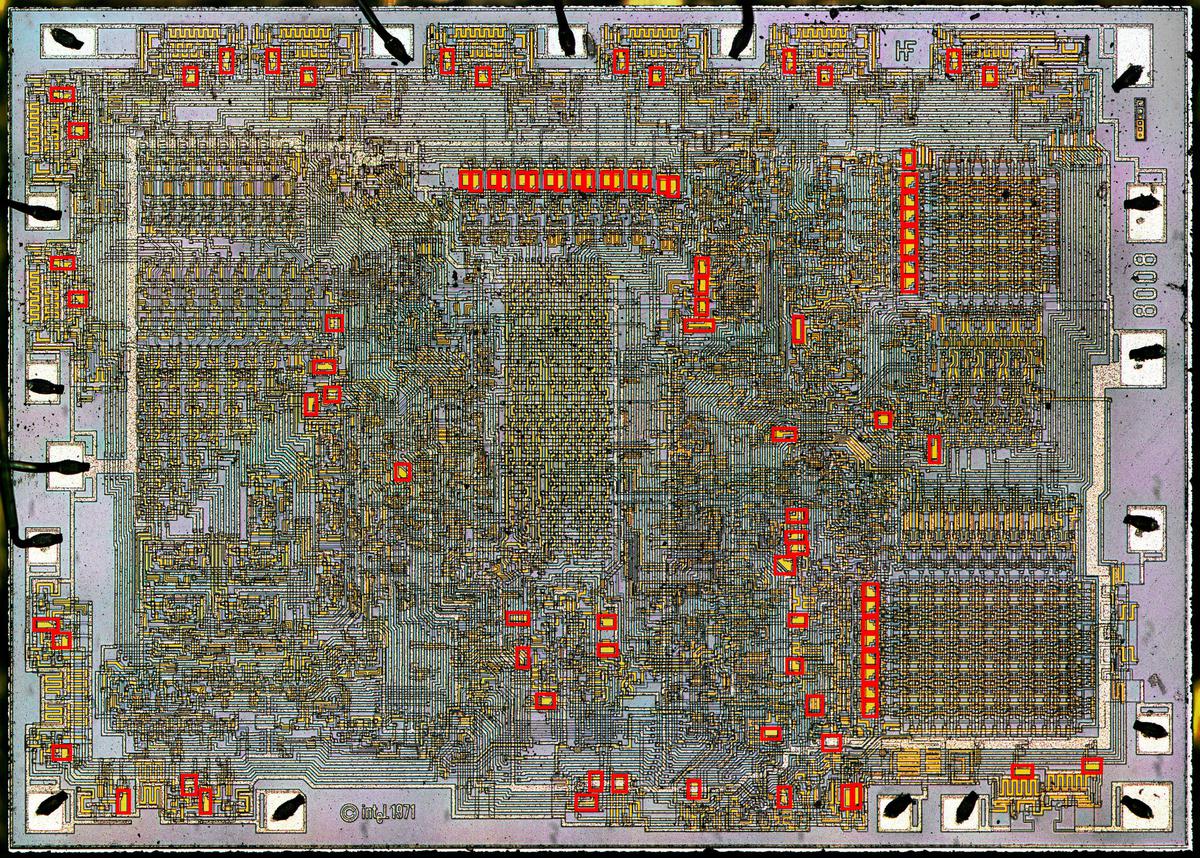
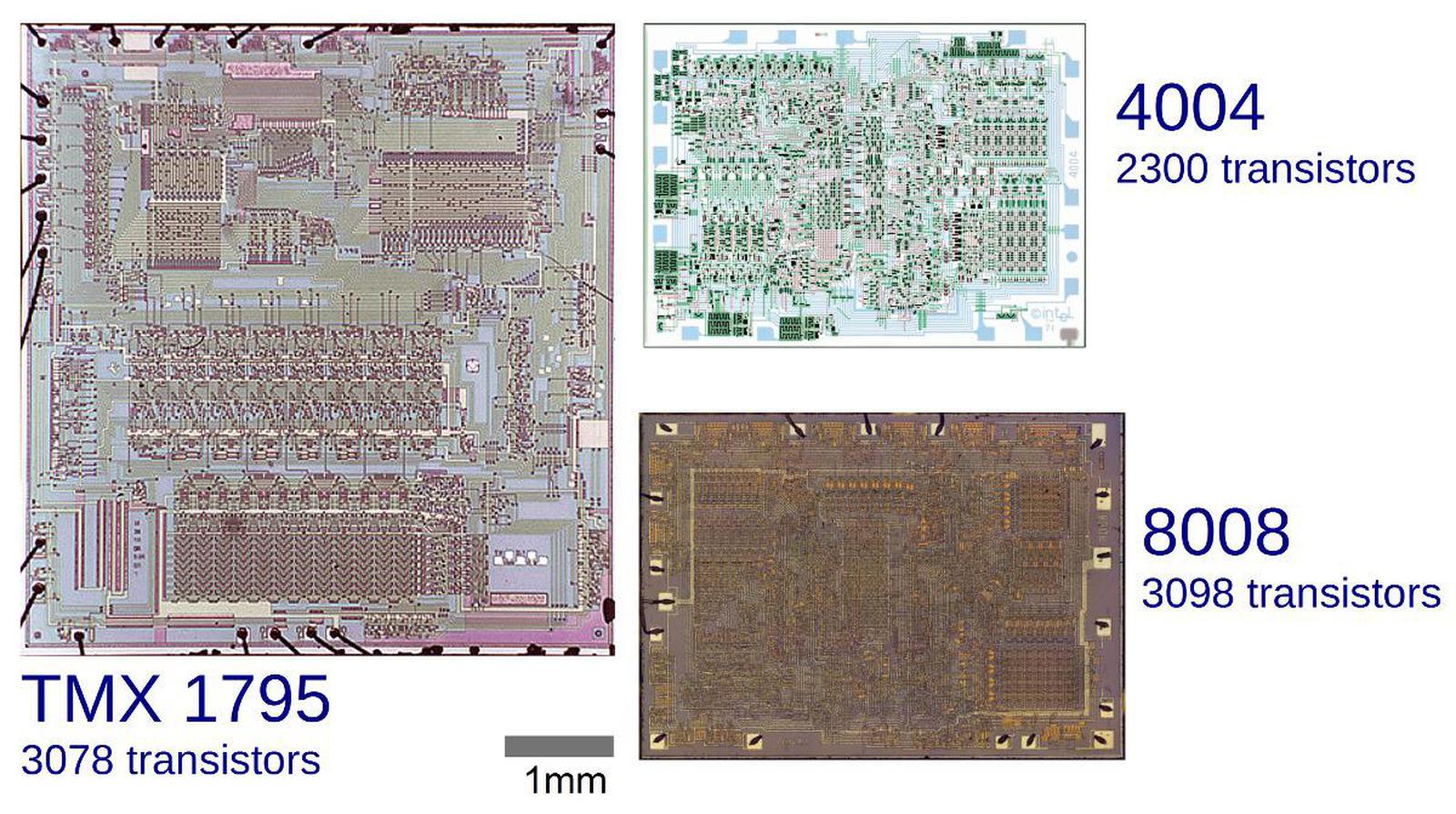
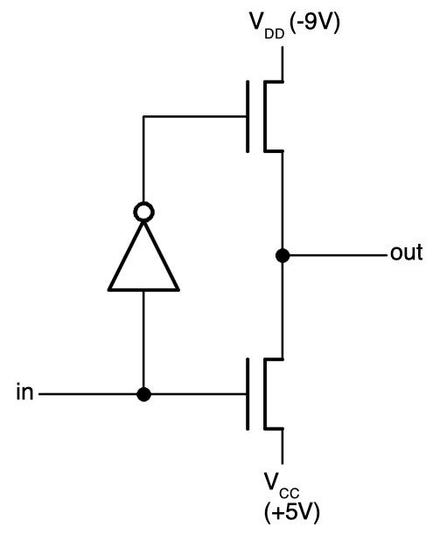
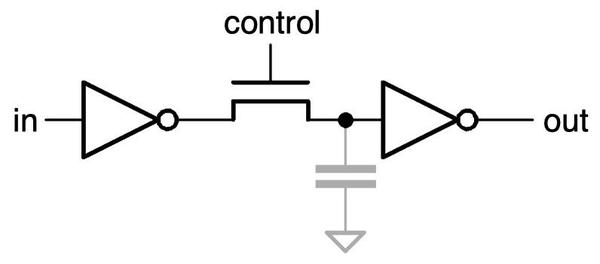
2 comments:
Ken your posts on the reverse engineering of microprocessors is always a detailed and thoroughly explained. I enjoy them a lot. Have you thought about combining them into a coherent whole as an e-book maybe?
An very well-written article describing the bootstrap load, both technically and in historical context!
Post a Comment